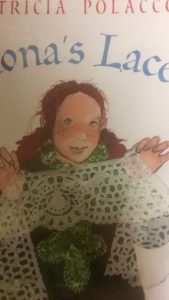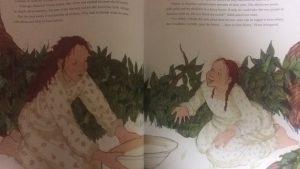

Author/Illustrator: Patricia Polacco
Publisher/Year: Simon and Schuster 2014
Number of Pages: 36
Genre: Historical Fiction
Analysis
Fiona, her sister Ailish, mother, and Da all live in Ireland. After the mill in the village closes, Fiona and her family set their sights for America. They decided to leave their beloved Ireland and immigrate to Chicago, Illinois. They all must find work to make money, so Fiona, having been taught by her mum, makes fine white lace for the richer folks to buy.
Green and white are important colors throughout the book. First of all, the colors green and white appear on the Irish flag. Green symbolizes nationalism and white symbolizes peace. Regarding the book, green can symbolize rebirth as the family leaves behind the only life they know to travel and move to another country, creating a new life for themselves. White is a universal symbol for purity. Fiona’s white lace that she creates symbolizes her innocence and that fact that she is still a child. But as a fire breaks out, she leaves her lace behind in pieces so her parents are able to find her and Ailish. After Fiona and Ailish are reunited with their parents, the lace is covered in black soot. The black soot covering the white lace could symbolize the end of Fiona’s innocence because the fire marks her lace as well as her understanding of her world.
The illustrations are not framed so the reader is involved with the story, unlike an outsider looking in. In the beginning of the story, there are more colors present, but as the book progresses, the author uses fewer and fewer colors. The text could stand alone without the pictures, but most children wouldn’t know what Ireland or Chicago looked like, so the pictures do help to give an idea of the setting.
This book can act as a window for children to learn about families who have immigrated from other countries to America. It shows the stereotypical flaming red Irish hair and freckles as well as popular Irish names. In the end, children see a different culture from their own.
